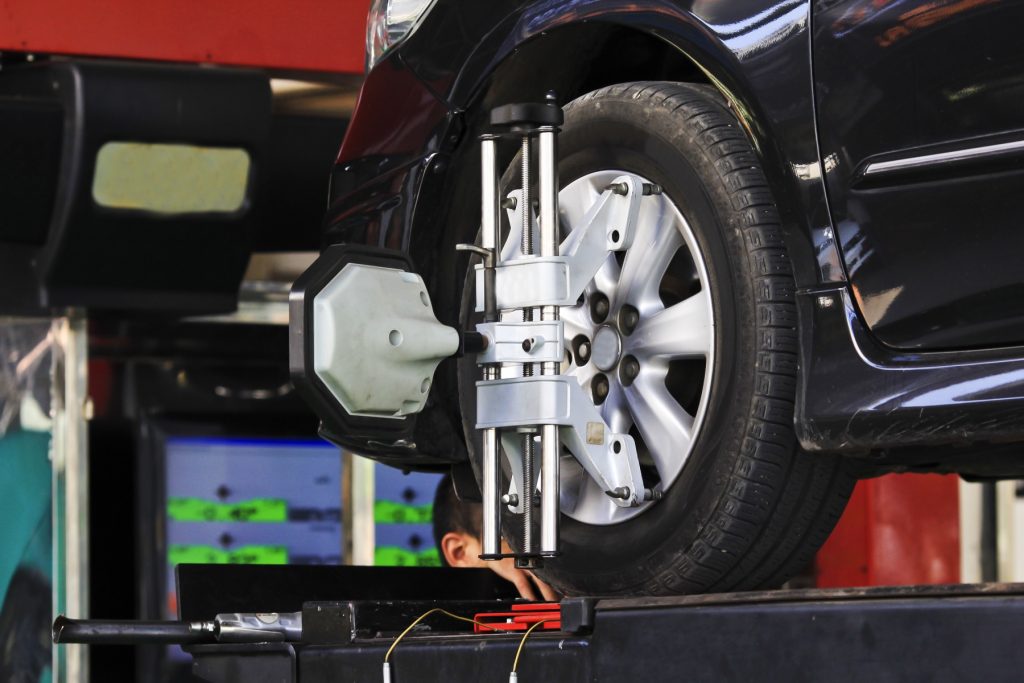Wheel alignment is a significant tyre wear indicator that many car owners don’t think about. Wheel alignment involves adjusting the angles of your vehicle’s wheels so that they are parallel to each other and perpendicular to the ground. Proper wheel alignment not only ensures smooth and comfortable driving but also significantly extends the lifespan of your vehicle’s tyres. In this article, we will delve deeper into the importance of wheel alignment, its effects as a tyre wear indicator, and how often you should get your wheels aligned.
What is a Wheel Alignment?
So, what is a wheel alignment? Also known as tracking, wheel alignment refers to adjusting your vehicle’s wheel angles so that they are perfectly parallel to each other and perpendicular to the ground. Good wheel alignment means your tyres make optimal contact with the road surface. You can’t adjust your wheel alignment at home, however – it is a complex process that requires professional equipment, as it involves adjusting your vehicle’s suspension, not just the tyres and wheels themselves. Why not book your vehicle in for a service today?
Why is Wheel Alignment important?
1. Improves your handling and safety
When the wheels are correctly aligned, the vehicle responds better to your steering and is thus easier to control. Good wheel alignment is critical during emergencies where quick and precise steering is required to avoid accidents. Poor wheel alignment can make your vehicle pull to one side, which is dangerous, especially at high speeds or in adverse weather conditions.
2. Saves you money – more efficient
Did you know proper wheel alignment can also increase your fuel efficiency? Bad wheel alignment means unnecessary drag, causing your engine to work harder and consume more fuel. Ensuring that your vehicle has correct wheel alignment reduces this drag and improves your vehicle’s fuel economy! This saves you money at the pump and contributes to environmental conservation by reducing your vehicle’s carbon footprint.
3. Extends your tyre lifespan
The tyre wear patterns bad wheel alignment creates are obvious. With poor wheel alignment, certain areas of the tyres bear more weight and experience increased friction with the road surface. This uneven distribution of weight and friction leads to accelerated tyre wear patterns, reducing their lifespan. By getting regular wheel alignments as part of your service, you can ensure that your vehicle’s weight is evenly distributed, resulting in longer-lasting tyres. This can save you money in the long run by reducing the frequency of tyre replacements needed!
Effects of Misaligned Wheels on Tyre Wear
1. Uneven Tyre Wear
As mentioned, one significant effect of misaligned wheels is uneven tyre wear. In improper wheel alignment, certain areas of the tyres will wear out faster than others. You might see tyre wear patterns like excessive wear on the inner or outer edges of the tyres. Uneven tyre wear not only compromises the performance of the tyres but also poses a safety risk, especially in wet or slippery conditions. Tyre wear patterns can also lead to vibrations while driving, which can be uncomfortable and distracting.
2. Increased Risk of Blowouts
When the tyres wear unevenly due to bad wheel alignment, they become more susceptible to damage and punctures. This can lead to sudden blowouts while driving, which can be extremely dangerous, especially at high speeds. Regular wheel alignments can help prevent such incidents and ensure you stay safe on the road. It’s worth noting that tyre blowouts can also lead to costly repairs or replacements, so regular wheel alignments can save you money.
3. Reduced Traction
Proper wheel alignment is essential for maintaining the best traction between your tyres and the road surface. Misaligned wheels can reduce traction, especially when you turn a corner or brake. Bad wheel alignment can also mean longer stopping distances and compromised handling, increasing the risk of accidents. By getting regular wheel alignments, you can ensure your tyres maintain maximum traction, providing safer driving.
How Often Should You Get a Wheel Alignment?
The frequency of wheel alignments depends on various factors, including driving habits, road conditions, and vehicle type. As a general rule of thumb, we recommend you get a wheel alignment every 10,000 to 12,000 miles or at least once a year. However, if you notice any signs of misalignment, such as uneven tyre wear or steering pulling to one side, getting a wheel alignment as soon as possible is advisable.
Certain events can mean you should get a wheel alignment sooner than these recommended intervals. For instance, if you’ve been involved in a car accident, hit a pothole, or replaced your tyres, you should consider getting a wheel alignment to ensure that your vehicle continues to perform optimally.
Wheel alignment is a critical aspect of vehicle maintenance that should not be overlooked. By getting regular wheel alignments, you can ensure your vehicle performs optimally and enjoy a smoother, safer, and more cost-effective drive. So, don’t neglect wheel alignment – make it a priority! Contact us today to book your wheel alignment.


Leave a Reply